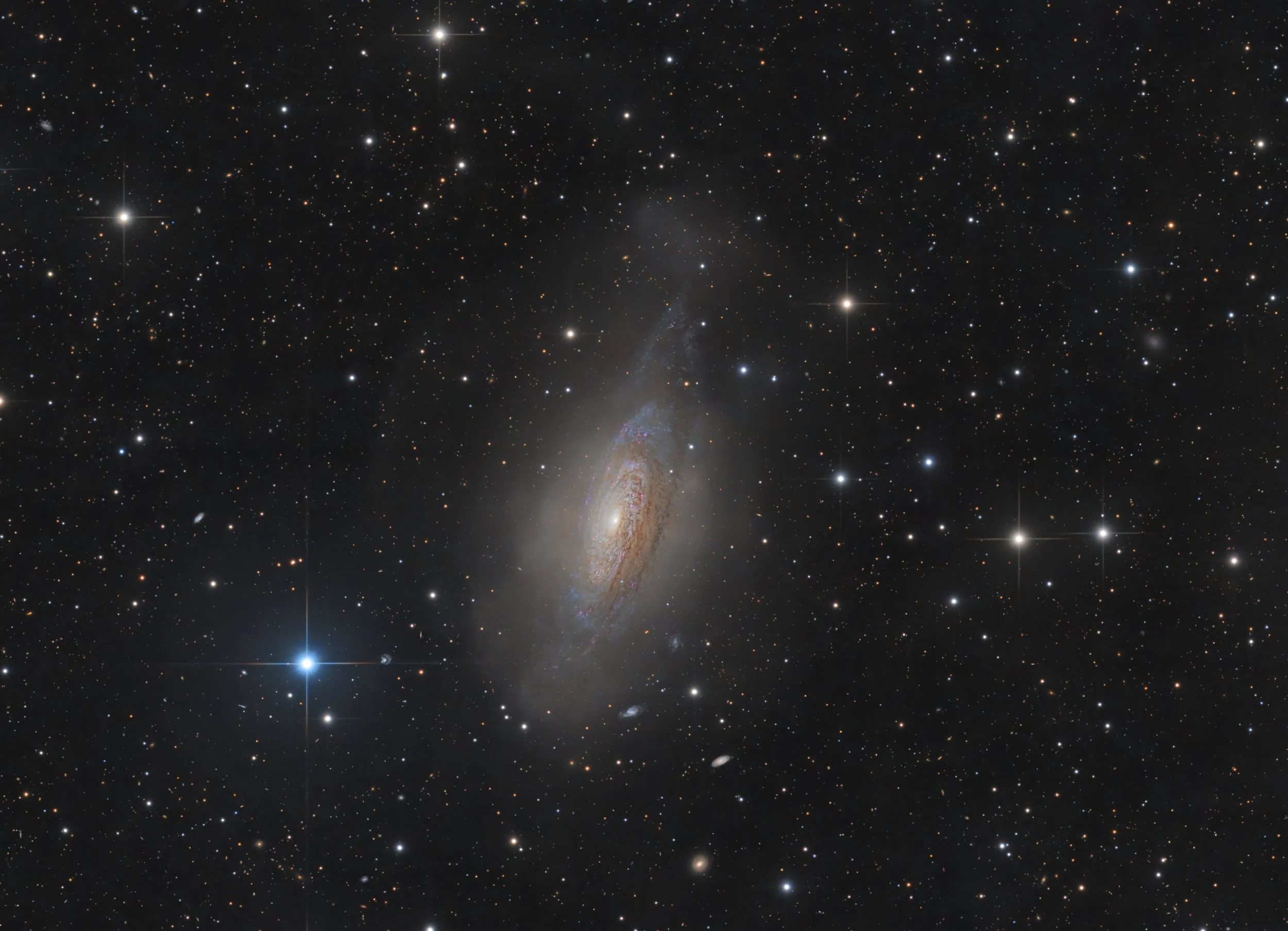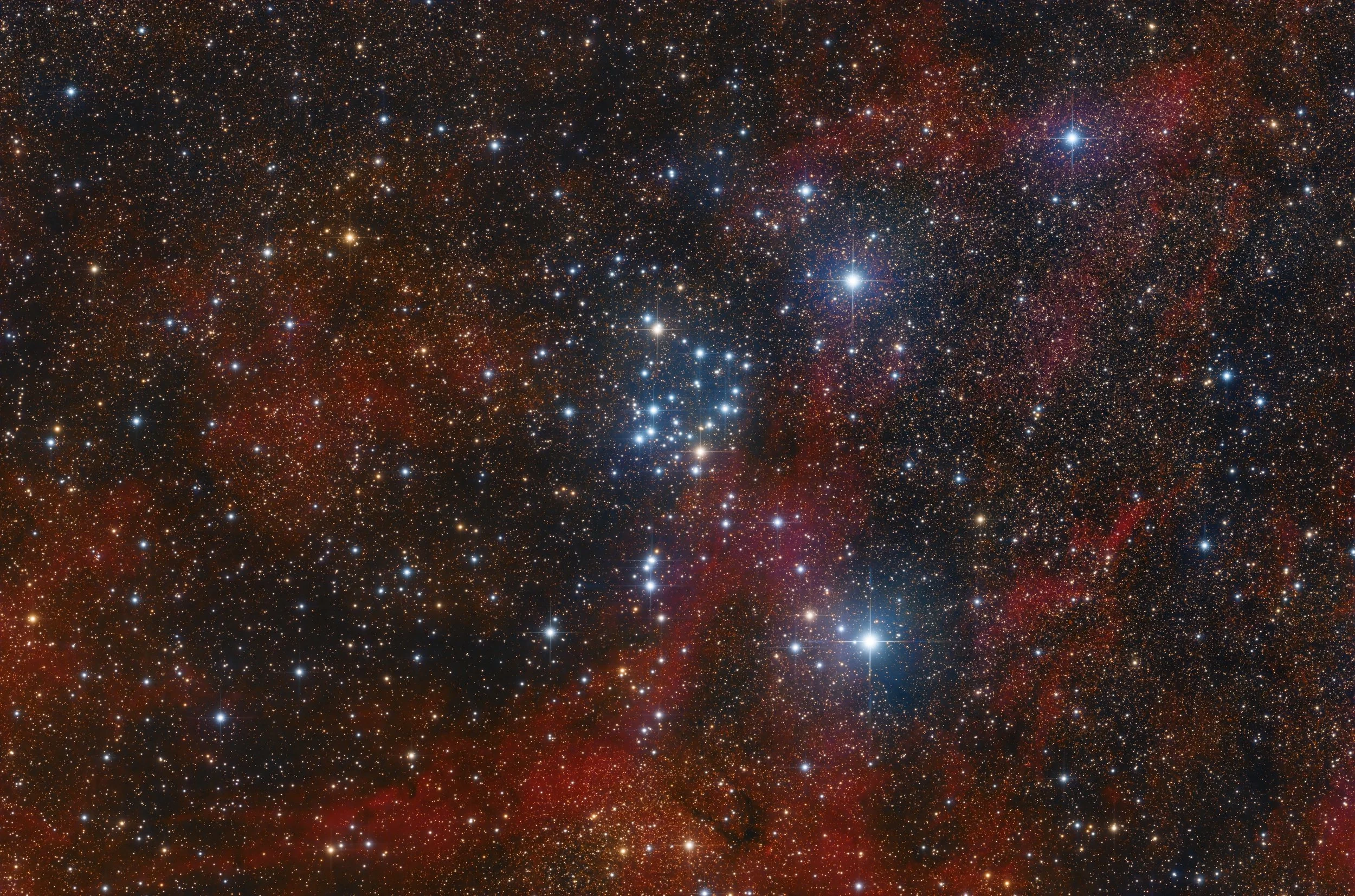
AAPOD2 Image Archives
NGC 3521 - the Bubble Galaxy
NGC 3521, also known as the Bubble Galaxy, is a majestic spiral galaxy located in the constellation Leo. This galaxy is characterized by its bright core and the distinctive, bubble-like structures of its spiral arms. These features give it a unique appearance, making it a favorite target for astrophotographers and astronomers alike. The galaxy lies approximately 26 million light-years from Earth and spans about 50,000 light-years in diameter.
This detailed image of NGC 3521 was captured with a total exposure time of 22 hours and 21 minutes. The breakdown of the exposure times is as follows: 347 minutes for the luminance filter, and 85 minutes each for the red, green, and blue filters, with individual exposures of 120 seconds. This long integration time allowed for the capture of the intricate details and subtle structures within the galaxy, highlighting its vibrant colors and the delicate nature of its spiral arms. The result is a breathtaking view of the Bubble Galaxy, showcasing its beauty and complexity.
Open clusters in a colorful environment (NGC 6281)
NGC 6281 is an open cluster located in the constellation Scorpius. This cluster is a rich and bright group of stars, easily visible with small telescopes and even binoculars under good conditions. NGC 6281 lies approximately 5,500 light-years from Earth and has an apparent magnitude of 5.4, making it one of the more prominent open clusters in the night sky.
The cluster consists of a diverse array of stars, with many different magnitudes and colors, adding to its visual appeal. Observing NGC 6281, one can appreciate the beauty and complexity of star formation and the dynamics of stellar clusters. The cluster's relatively dense population of stars provides an excellent opportunity for both amateur and professional astronomers to study stellar evolution and the properties of young star clusters.
M 25 - bright and colorful stars in front of a sea of stars
M25, also known as the IC 4725 open cluster, is a dazzling assembly of stars situated in the constellation Sagittarius. This cluster shines brightly against the backdrop of the Milky Way, appearing like a jewel in the night sky. Comprising hundreds of stars, M25 presents a breathtaking display of stellar diversity, with stars of various colors and magnitudes dotting its celestial canvas.
The cluster's proximity to the galactic plane makes it immersed in a sea of stars, enhancing its visual appeal and creating a mesmerizing tapestry of light. With its rich concentration of stars and intricate patterns, M25 offers astronomers and stargazers alike a captivating glimpse into the beauty and complexity of our galaxy.
Messier 81 - Bode's galaxie in Ursa Major
M81, also known as Bode's Galaxy, is a striking spiral galaxy located in the constellation Ursa Major, approximately 11.8 million light-years away from Earth. It is one of the brightest galaxies visible in the night sky and is a prominent member of the M81 Group, a small galaxy group that includes several other galaxies.
What sets M81 apart is its remarkable appearance and structure. It features grand spiral arms filled with young, hot stars, interspersed with dark dust lanes and glowing regions of star formation. At its center lies a supermassive black hole with a mass equivalent to approximately 70 million times that of the Sun. M81 is also notable for its interaction with its smaller neighbor, M82, which has led to the distortion of M81's outer spiral arms.
Studying M81 provides astronomers with valuable insights into the processes of galaxy formation and evolution. Its proximity to Earth and its clear, detailed structure make it an ideal target for observational studies aimed at understanding the dynamics of spiral galaxies and the role of interactions and mergers in shaping their properties.
NGC 6752 Globular Cluster in Pavo
Image Description and Details :
NGC 6752 is a globular cluster in the constellation Pavo. It is the fourth-brightest globular cluster in the sky (after Omega Centauri, 47 Tucanae and Messier 22). The cluster lies around 13,000 light-years distant and is one of the closer globular clusters to Earth and has been calculated to be 11.78 billion years old.Telescope 20" Cassegrain f/3 (1500 mm) Camera Moravian G2 8300 monoExposure RGB 4x2min each (total 24min) Software PixInsight Location IAS Hakos Farm, Namibia
Copyright: Herbert Walter
NGC 6811 - an open clusters in the constellation Cygnus
NGC 6811 is the cluster of weak stars in the left part of the image, though the bright stars in the upper right corner are more prominent.
Trumpler classification: IV 3 p
Stars: 70
Size: 13'
brightest Star: 9.9 mag
Telescope / Camera: LACERTA Newton 10"/f4 / Moravian G2 8300 mono
Exposure: L/R/G/B 4h 50min
Location: Inzersdorf im Kremstal / Austria
Copyright: Herbert Walter







